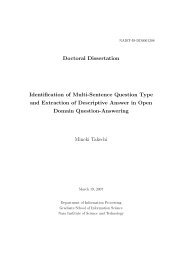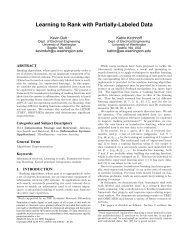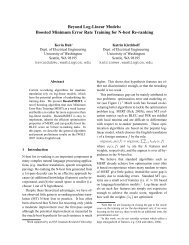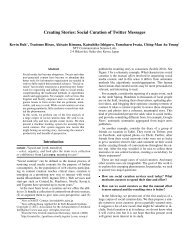The NAIST Dependency Parser for SANCL2012 Shared Task
The NAIST Dependency Parser for SANCL2012 Shared Task
The NAIST Dependency Parser for SANCL2012 Shared Task
Create successful ePaper yourself
Turn your PDF publications into a flip-book with our unique Google optimized e-Paper software.
Our parser uses POS tags provided by the<br />
Stan<strong>for</strong>d POS tagger (Toutanova et. al., 2003).<br />
<strong>The</strong> model is trained on the provided labeled<br />
training data, with the following training options:<br />
bidirectional5words, naacl2003unknowns and<br />
wordshapes(-1,1). <strong>The</strong> number of iterations was 10.<br />
We used only the Penn Tagset and did not experiment<br />
with the Universal POS-set provided with the<br />
training data (due to time constraints).<br />
3 Extensions <strong>for</strong> Domain Adaptation<br />
<strong>The</strong>oretically, we can view the domain adaptation<br />
problem as a change in the distribution p(x, y) =<br />
p(y|x)p(x), where p(x) is the input distribution of<br />
sentences and p(y|x) is the conditional distribution<br />
of parse y given sentence x (Jiang and Zhai, 2007).<br />
Either p(x) or p(y|x) may vary as we move across<br />
domains, and mismatch in either (with respect to the<br />
training data) leads to per<strong>for</strong>mance degradation. Our<br />
dependency-based cluster tackles mismatch in p(x)<br />
by tying together word features, while our consensus<br />
label approach attempts to reduce p(y|x) mismatch<br />
by re-training on auto-parses of web data.<br />
3.1 <strong>Dependency</strong>-based Cluster Features<br />
Word clusters have been shown to give good per<strong>for</strong>mance<br />
<strong>for</strong> dependency parsing, especially in the<br />
context of semi-supervised parsing (Koo et. al.,<br />
2008). Here we follow Koo’s approach in incorporating<br />
word clusters as additional features into the<br />
parser. However, rather than cluster using word n-<br />
gram in<strong>for</strong>mation, we cluster using dependency n-<br />
gram in<strong>for</strong>mation. <strong>The</strong> motivation is that head/child<br />
in<strong>for</strong>mation may provide more useful generalizations<br />
than neighboring left/right context (Sagae and<br />
Gordon, 2009; Haffari et. al., 2011). In particular,<br />
we first parse the unlabeled data with the MST<br />
<strong>Parser</strong>, then extract head-child in<strong>for</strong>mation as bigram<br />
dependencies. This is given to the Brown clustering<br />
algorithm 2 , generating 32 cluster features <strong>for</strong><br />
the shift-reduce parser.<br />
3.2 Consensus Labels from Unlabeled Data<br />
Self-training and co-training can be effective methods<br />
<strong>for</strong> domain adaptation (McClosky et. al., 2008).<br />
Here we experimented with a co-training scheme<br />
2 cs.stan<strong>for</strong>d.edu/∼pliang/software/brown-cluster-1.2.zip<br />
where consensus parses provided by the MST parser<br />
and Berkeley parser 3 are given to our shift-reduce<br />
parser. Specifically, we parsed the unlabeled training<br />
data with the MST parser and the Berkeley<br />
parser, both trained on the labeled training data.<br />
<strong>The</strong>n we converted the outputs of the Berkeley<br />
parser into dependency trees and extracted trees on<br />
which the two parsers reached a (exact-match) consensus<br />
in terms of the unlabeled arc structure. As<br />
a result 5,200 trees were extracted, and we added<br />
them to the training data <strong>for</strong> the submitted system.<br />
For POS tags and the edge labels, we used the outputs<br />
of the Stan<strong>for</strong>d POS tagger and the MST parser.<br />
4 Preliminary Experiments and Discussion<br />
Tables 1 and 2 show the UAS and LAS on the<br />
Dev data, using either true (goldtag) or predicted<br />
(autotag) POS tags. <strong>The</strong> baseline system is our<br />
shift-reduce parser trained on the labeled newswire<br />
training data (dataset 1), without any extensions<br />
<strong>for</strong> adaptation. <strong>The</strong> +ngramcluster is the baseline<br />
system enhanced with ngram-based clusters like<br />
(Koo et. al., 2008), while +depcluster is the one<br />
enhanced with dependency-based clusters. Systems<br />
using additional consensus labels are indicated<br />
by +consensus. Our official submission is baseline+consensus+depclusters,<br />
which is the best of<br />
the bunch in general and observes a slight improvement<br />
of 0.2 UAS in EMAIL (autotag) and of 0.3<br />
UAS in WEBLOG (autotag) over baseline. <strong>The</strong> test<br />
results are shown in Table 3.<br />
Due to time constraints 4 , we did not attempt many<br />
important experimental variations. Although the<br />
slight improvements are promising, we think the following<br />
future work are worth investigating in detail:<br />
• Word clustering with combined n-gram and<br />
syntax in<strong>for</strong>mation, since it is likely a single<br />
view is ineffective in clustering rare words.<br />
• Consensus labels derived from partial parse<br />
matches, since exact match is too strict and<br />
generates too few additional labels.<br />
• Analysis and quantification of p(x) and p(y|x)<br />
mismatches in web data. Which one is more<br />
serious and deserves more research?<br />
3 http://code.google.com/p/berkeleyparser/<br />
4 We had a late start in participating in this shared task.










